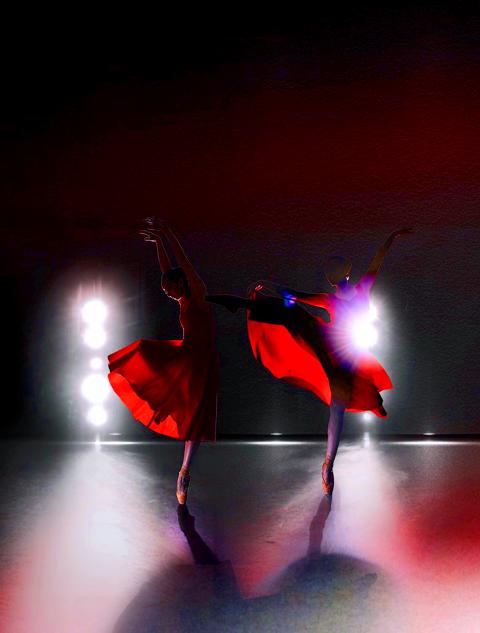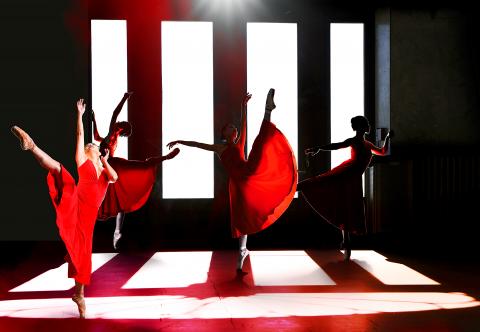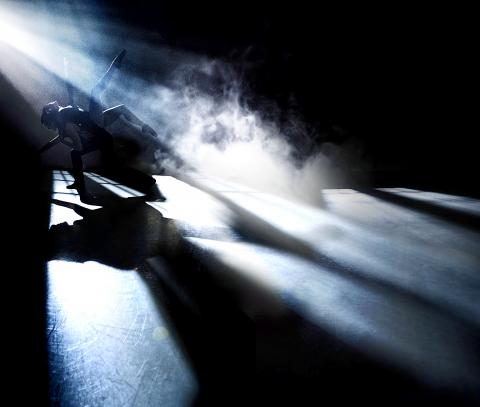To celebrate the Kaohsiung City Ballet’s (KCB, 高雄城市芭蕾舞團) 25th anniversary, founder Chang Hsiu-ru (張秀如) decided to stage a production based on Vivaldi’s The Four Seasons, asking two choreographers who have worked with the troupe on previous shows to create two new works.
The dances created for Light (光), which opens on Saturday at Kaohsiung Cultural Center’s Chihteh Hall, could not be more different.
Romanian choreographer/multimedia artist Constantin Georgescu’s piece is about time, space and light and makes use of red ropes and digital technology, while 27-year-old Taiwanese Lai Hung-chung (賴翃中) took a biblical passage about using light as a symbol for guidance as inspiration for his dance.

Photo: Liu Ren-haur
MOVING PAINTINGS
Georgescu has been working with the company on and off since 2014, helping Chang restage full-length productions of Coppelia in 2014 and The Nutcracker the following year. He has also created works for the company’s young choreographer platform, the annual “Dance Shoe” productions.
However, he first came to the Taiwan dance world’s attention five years ago when Germany-based dancer Yuan Shang-jen (袁尚仁) asked him to collaborate on a piece for the 2013 Meimage Dance Company’s New Choreographer Project. Their piece, Dialogue (對話), had great dancing and superb video projections.

Photo: Liu Ren-haur
Even when he is not in Taiwan, Georgescu, who is now working on a graduate degree in Austria, maintains a strong Taiwanese connection: He has spent the past year working with Landestheater Linz Ballet artistic director Lin Mei-hong (林美虹), a Taiwanese choreographer who has been based in Europe for more than three decades.
Georgescu followed Chang’s request to use Vivaldi’s The Four Seasons for his music, but he chose Max Richter’s interpretation of the composition.
“Light is a series of moving ‘paintings’ dealing with time, space and light, each part has its own identity and can be seen as a standalone moment, but I have tried to build on the possibility of one piece made of different movements,” Georgescu says.

Photo: Liu Ren-haur
“It has a cyclical development that works closely with the music. The idea of time passing from this piece of music is a very good support for the choreographic and dramaturgical development.”
He says Light was also influenced by his experience of growing up and watching how people connect, disconnect and influence others.
By using live video projection, Georgescu wants to give audiences a new perspective, a chance to observe connections as they are being made — or unmade.

Photo: Liu Ren-haur
THE MORNING STAR
For his work, Lai turned to several dancers whom he has been working closely with for the past year, Cheng I-han (鄭伊涵), Chien Lin-yi (簡麟懿) — who were so terrific in Lai’s Raining in the Room for this year’s “Dance Shoe” and former Cloud Gate Dance Theater member Huang Lu-kai (黃律開). Chang Yu (張瑀) completes the cast.
Lai said Chang’s theme of “light” made him think of Lucifer and a passage from the Bible, Isaiah 14:12-15, that begins: “How you have fallen from heaven, morning star, son of the dawn! You have been cast down to the earth, you who once laid low the nations!”
The idea of the morning star, the brightest object in the pre-dawn sky besides the moon, being hard to see in daylight captured his imagination, Lai says. Lai likens it to life, where knowing what choices to make and finding the right direction can be hard, even when everyting seems clear.
However, life does seem to be moving in the right direction for Lai right now. Just a month after his Watcher won third prize and the critics’ prize at the 31th International Choreographic Competition in Hannover, Germany, his Birdy last week scooped first prize at the 16th Burgos & New York International Choreography Competition in Burgos, Spain.
Birdy features Cheng and Huang.
Watcher, set on Cheng and Chien, also made it to the semi-finals of the Burgos competition, which featured 14 of the 134 dances that were entered. It did not win a prize.
Lai is the second Taiwanese choreographer to take first place at the Burgos competition, following in the footsteps of Benson Tsai (蔡博丞) in 2015, who also created several pieces for the KCB before striking out on his own.
With the win in Burgos came an invitation to return to Spain in May next year to perform in the annual Festival of Theater and Street Arts of Valladolid. However, Lai and his dancers will be heading back even sooner, as he has a work entered in MASDANZA International Choreography and Competition in the Canary Islands in October.
Lai and Tsai’s success on the international choreographic circuit is just the latest proof, if more was needed, that Chang has an eye for talent, be they dancers or choreographers. She has been a mainstay of modern-dance focused Taiwan’s ballet world for decades, so her company’s 25th anniversary is certainly something worth celebrating.
Light runs 65 minutes with a 15 minute intermission. The company will take the show on the road later this month with a performance in Taichung on Aug. 22 in Pingtung County on Aug. 28.

In the March 9 edition of the Taipei Times a piece by Ninon Godefroy ran with the headine “The quiet, gentle rhythm of Taiwan.” It started with the line “Taiwan is a small, humble place. There is no Eiffel Tower, no pyramids — no singular attraction that draws the world’s attention.” I laughed out loud at that. This was out of no disrespect for the author or the piece, which made some interesting analogies and good points about how both Din Tai Fung’s and Taiwan Semiconductor Manufacturing Co’s (TSMC, 台積電) meticulous attention to detail and quality are not quite up to

April 21 to April 27 Hsieh Er’s (謝娥) political fortunes were rising fast after she got out of jail and joined the Chinese Nationalist Party (KMT) in December 1945. Not only did she hold key positions in various committees, she was elected the only woman on the Taipei City Council and headed to Nanjing in 1946 as the sole Taiwanese female representative to the National Constituent Assembly. With the support of first lady Soong May-ling (宋美齡), she started the Taipei Women’s Association and Taiwan Provincial Women’s Association, where she

Chinese Nationalist Party (KMT) Chairman Eric Chu (朱立倫) hatched a bold plan to charge forward and seize the initiative when he held a protest in front of the Taipei City Prosecutors’ Office. Though risky, because illegal, its success would help tackle at least six problems facing both himself and the KMT. What he did not see coming was Taipei Mayor Chiang Wan-an (將萬安) tripping him up out of the gate. In spite of Chu being the most consequential and successful KMT chairman since the early 2010s — arguably saving the party from financial ruin and restoring its electoral viability —

It is one of the more remarkable facts of Taiwan history that it was never occupied or claimed by any of the numerous kingdoms of southern China — Han or otherwise — that lay just across the water from it. None of their brilliant ministers ever discovered that Taiwan was a “core interest” of the state whose annexation was “inevitable.” As Paul Kua notes in an excellent monograph laying out how the Portuguese gave Taiwan the name “Formosa,” the first Europeans to express an interest in occupying Taiwan were the Spanish. Tonio Andrade in his seminal work, How Taiwan Became Chinese,